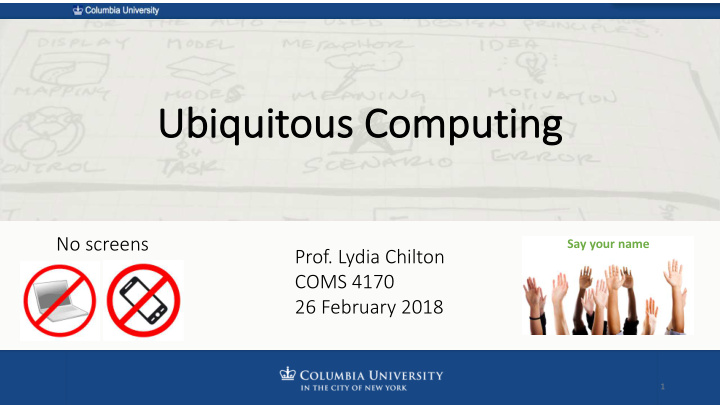



Ub Ubiq iquit itou ous Com omputin ing No screens Say your name Prof. Lydia Chilton COMS 4170 26 February 2018 1
1940s – 1960s mputers : Tools for Calculation and Co Comp Symbolic Manipulation 2
1945 Co Comp mputer ers : tools to augment human cognition Vannevar Bush’s vision of computers 3
Memex inspired the First Graphical User Interface 1963: Ivan Sutherland’s CAD software, Sketchpad 4
Memex inspired the first interaction devices 1968: Douglas Engelbart’s mouse 5
Memex inspired the Internet 1969: ARPANET’s 6
The result of the Memex vision? NAILED IT! 7
What comes next? September 1991 8 Scientific American
“The most profound technologies are those that disappear . They weave themselves into the fabric of everyday life until they are indistinguishable from it.” Writing is the first But also street signs, graffiti, Writing is ubiquitous. information technology and candy wrappers. It is in books… And we hardly notice it anymore. 9
“The most profound technologies are those that disappear . They weave themselves into the fabric of everyday life until they are indistinguishable from it.” Writing is the first But also street signs, graffiti, Writing is ubiquitous. information technology and candy wrappers. Writing is so ubiquitous, it disappears . It is in books 10
1991: Computers have not disappeared. (Have not woven themselves into our lives) Writing is the first information technology 11
1991: Computers have not disappeared. (Have not woven themselves into our lives) Writing is the first Writing is ubiquitous. information technology It is in books… 12
1991: Computers have not disappeared. (Have not woven themselves into our lives) Writing is the first Writing is ubiquitous. But also street signs, graffiti, information technology It is in books… and candy wrappers that we hardly notice ? 13
Mark Weiser’s Vision of Computing 14
1991: 50 million PCs 15
16
17
18
3 Device Sizes: tabs, pads and boards ~100 tabs ~10 pads ~1 board 19
Tabs Uses: Size: doors open only to the right badge • wearer, rooms greet people by name, • Location: telephone calls can be automatically • forwarded to wherever the recipient may be, • receptionists actually know where people are, ~100 Number: computer terminals retrieve the • preferences of whoever is sitting at them, and • appointment diaries write themselves. 20
tabs” of 2018? What are the “ ta Size: Location: ~100 Number: 21
Pads Size: Location: Number: ~10 “Pads differ from conventional portable computers in one crucial way. Whereas portable computers go everywhere with their owners, the pad that must be carried from place to place is a failure . Pads are intended to be "scrap computers" (analogous to scrap paper) that can be grabbed and used anywhere; they have no individualized identity or importance.” 22
What are the “ pad ads ” of 2018? Size: Location: Number: ~10 “The pad that must be carried from place to place is a failure. Pads can be grabbed and used anywhere; they have no individualized identity or importance.” 23
Boards Size: Uses: in the home, video screens and bulletin boards; in the office, bulletin boards, Location: whiteboards or flip charts. Number: ~1 24
What are the “ boa oards ” of 2018? Size: Location: Number: ~1 25
How does si size and location correspond to the eeds of people? ab abilities ilities an and need 26
Summary of Mark Weiser’s Predictions Many displays throughout the home and office Devices range in size and location ~1 board, ~10 pads, ~100 tabs Devices will disappear the way writing disappears And becomes an effortless part of our lives. 27
2018: Device Sizes in my home 28
Computers in my home 29
30
31
32
33
34
35
36
2018 Device Count 37
My Count: 1 board, 2 pads, 4 tabs 38
What other devices do you have? What size and purpose do they have? 39
40
2007: Table Surfaces One example of a ubiquitous computing device 41
https://www.youtube.com/watch?v=kr1O917o4jI Microsoft Surface: Hands-on First Look | PopMech Published on May 30, 2007 42
2007 Surface: Ubiquitous Properties Size: Uses Draw • Resize photots • “Maps” • ”menus” • “Share photos” • Control your TV. • “Casinos” • Location: Number: ~1 43
What’s the difference? Uses When designing ubiquitous computing, Draw • Resize photots • “Maps” • purpose matters. ”menus” • “Share photos” • Control your TV. • 44 “Casinos” •
Evaluating Mark Weiser’s Vision 45
In what ways is this true today? “The most profound technologies are those that disappear . They weave themselves into the fabric of everyday life until they are indistinguishable from it.” 46
In what ways is this false today? “The most profound technologies are those that disappear . They weave themselves into the fabric of everyday life until they are indistinguishable from it.” 47
Summary 48
A vision of computing that disappears September 1991 49 Scientific American
1991: Computers have not disappeared. (Have not woven themselves into our lives) Writing is the first Writing is ubiquitous. But also street signs, graffiti, information technology It is in books… and candy wrappers that we hardly notice ? 50
Summary of Mark Weiser’s Predictions Many displays throughout the home and office Devices range in size and location ~1 board, ~10 pads, ~100 tabs Devices will disappear the way writing disappears 51
Vi Vision : tabs, pads and boards ~100 tabs ~10 pads ~1 board 52
Re Reality : tabs, pads and boards ~100 tabs ~10 pads ~1 board 53
What matters in Ubiquitous Computing: Si Size, Lo Location, Purp rpose These three things are essential in meeting the needs and abilities of people. 54
Recommend
More recommend